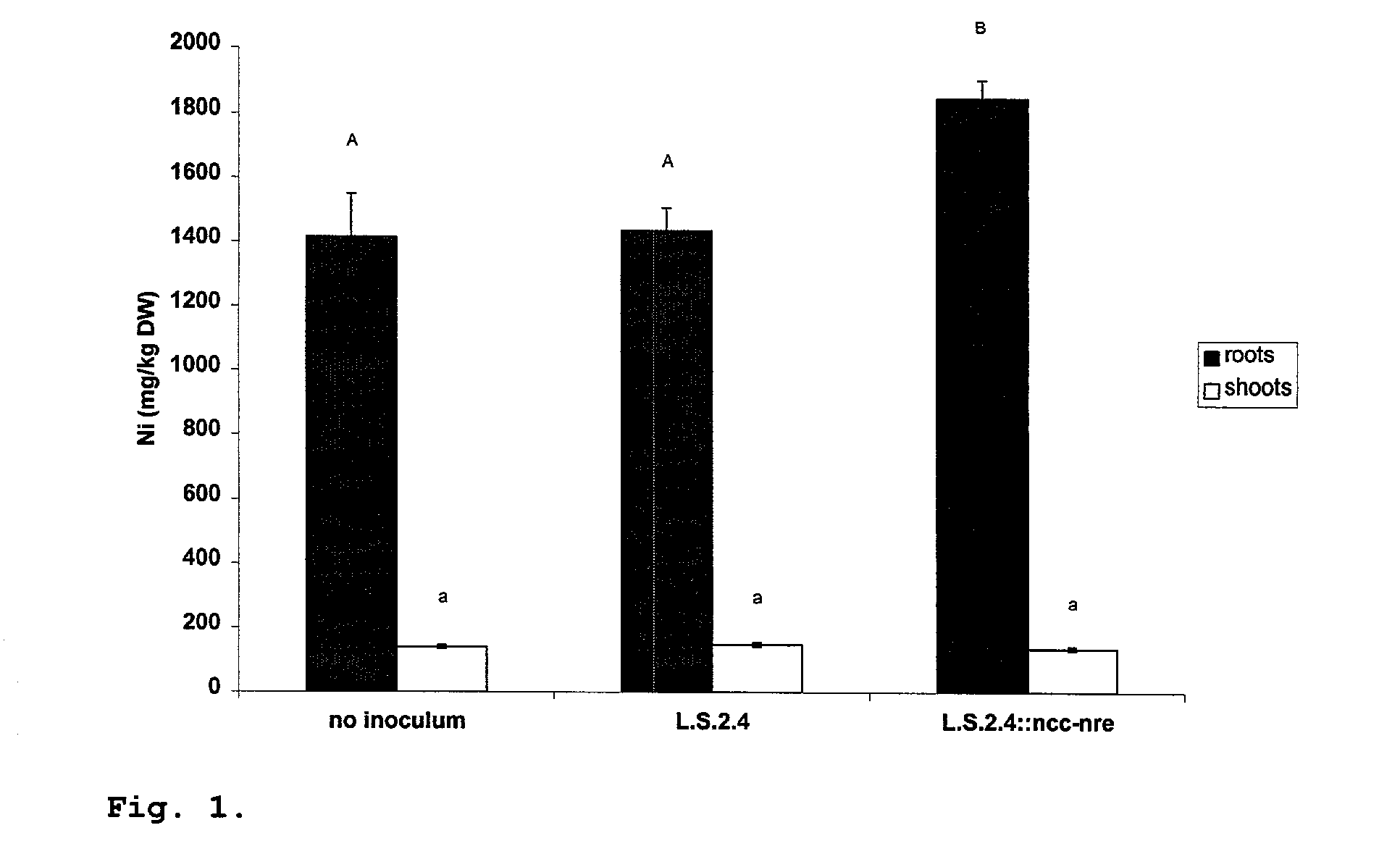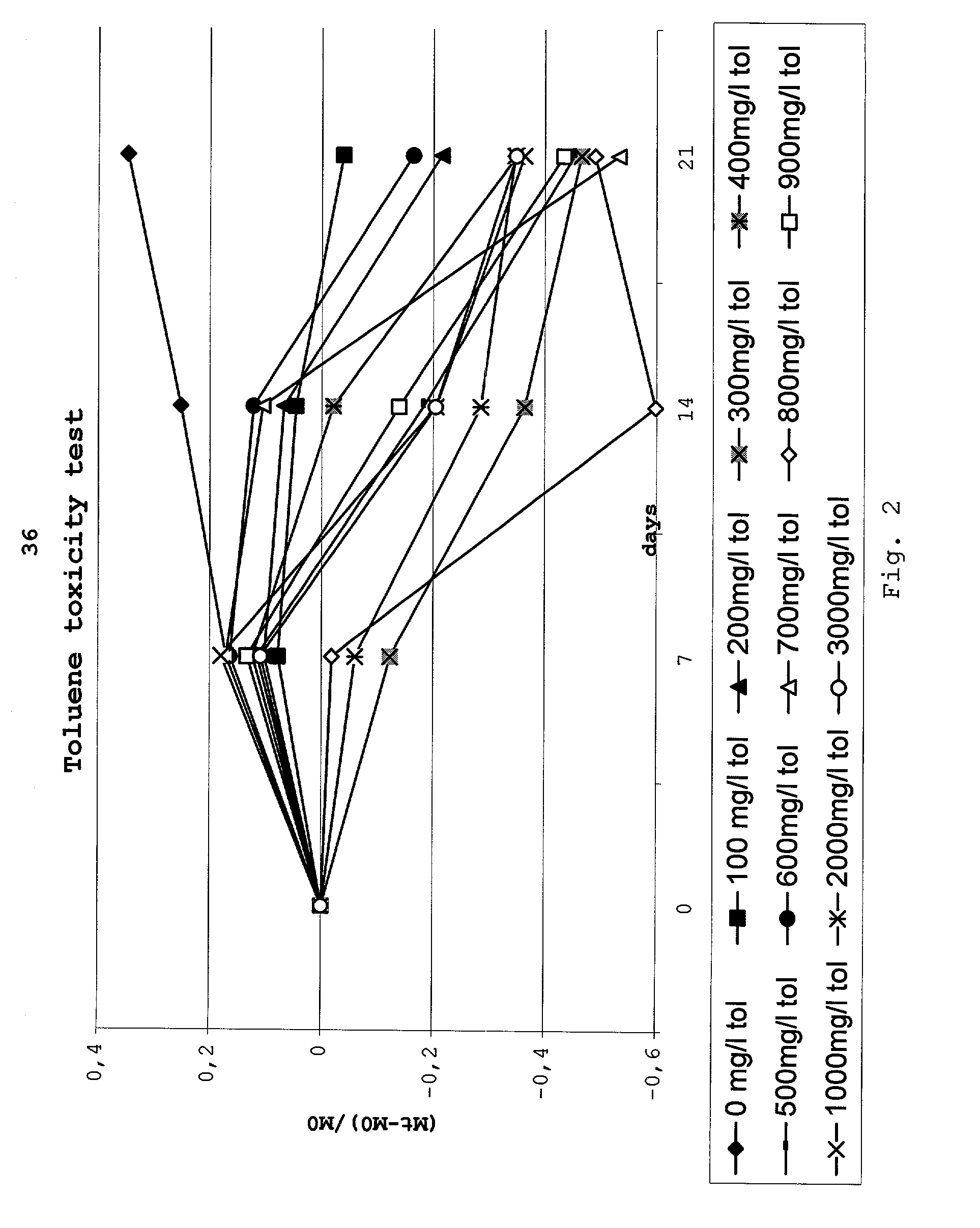Method for improving phytoremediation treatment of a contaminated medium
- Summary
- Abstract
- Description
- Claims
- Application Information
AI Technical Summary
Benefits of technology
Problems solved by technology
Method used
Image
Examples
example 1
Heavy Metal Sequestration by Natural and Genetically Modified Endophytic Bacteria
[0029] Pseudomonas sp. VM422 was isolated as an endophytic strain from surface sterilised Brassica napus. This strain was selected for its zinc resistance phenotype: VM422 had a MIC value for zinc of 20 mM on Tris minimal medium (Mergeay et al., 1985). This strain was tested for its zinc complexing capacity by growing it for 66 hours in liquid medium in the presence of 60000 .mu.g / l ZnCl.sub.2. After the incubation period, approximately 800 .mu.g / l Zn remained in the solution: the majority of the Zn was biosequestrated around the VM422 cells. For comparison, a similar experiment with Ralstonia metallidurans CH34, a well-known heavy metal sequestration bacterium (Diels et al., 1995), resulted in a decrease of Zn to 2730 .mu.g / l in the remaining solution. This experiment demonstrates the feasibility to use natural, heavy metal resistant endophytic bacteria for heavy metal sequestration from solution.
[0030...
example 2
Construction of Recombinant Endophytic Strains Equipped with Degradation Pathways for Specific Organic Xenobiotics
[0031] For construction of strains of endophytic bacteria with improved degradation capacity of organic xenobiotics (benzene, toluene, phenols and TCE) natural gene transfer was used. Natural gene transfer is based on bi or tri parental conjugation or exogenous plasmid isolation.
[0032] As a model endophytic strain to be equipped with degradation pathways was used a nickel-kanamycin marked derivative of Burkolderia cepacia L.S.2.4 named strain BU 0072, which was constructed at VITO (Taghavi, S. et all,2001). Burkolderia cepacia L.S.2.4 has yellow lupine (Lupinus luteus L.) as host.
[0033] As a donor strain for degradation pathway Burkolderia cepacia G4 (TOM, conjugative plasmid, tol.sup.+) was used.
[0034] Donor strain and receptor strain were grown overnight in LB medium, washed in 10.sup.-2 MgSO.sub.4 and aliquots of 100 .mu.l were added to a sterile filter (0.45 .mu.l ) ...
example 3
Development and Comparison Techniques for Efficient Reinoculation of Endophytic Strains in their Host Plants
[0041] After having marked and equipped endophytic bacteria with degradation pathways an efficient recolonization of host plant is an important prerequisite to evaluate their contribution inside of the plant to degrade the pollutants as they are being transported trough the plant and consequently reduce phytotoxicity and volatilization of the pollutants.
[0042] Preparation of Bacterial Inoculum:
[0043] A VM 1330 strain was grown in 284 tris buffered, salted, minimal liquid medium with addition of 0.2% gluconate at 22.degree. C. on rotary shaker for a period of 7 days. Next, inoculum was centrifuged at 6000 rpm during 15 minutes, washed twice in MgSO.sub.4.sup.-2. Inoculum was diluted and plated on 284 medium with addition of 1 mM Ni, 50 mg / l kanamicyne and toluene in order to test the purity of the solution and the presence of Ni, Km and toluene resistance characteristics.
[0044]...
PUM
| Property | Measurement | Unit |
|---|---|---|
| Mass | aaaaa | aaaaa |
| Mass | aaaaa | aaaaa |
| Mass | aaaaa | aaaaa |
Abstract
Description
Claims
Application Information
 Login to view more
Login to view more - R&D Engineer
- R&D Manager
- IP Professional
- Industry Leading Data Capabilities
- Powerful AI technology
- Patent DNA Extraction
Browse by: Latest US Patents, China's latest patents, Technical Efficacy Thesaurus, Application Domain, Technology Topic.
© 2024 PatSnap. All rights reserved.Legal|Privacy policy|Modern Slavery Act Transparency Statement|Sitemap



